한국응용과학기술학회 논문 검색
.jpg)
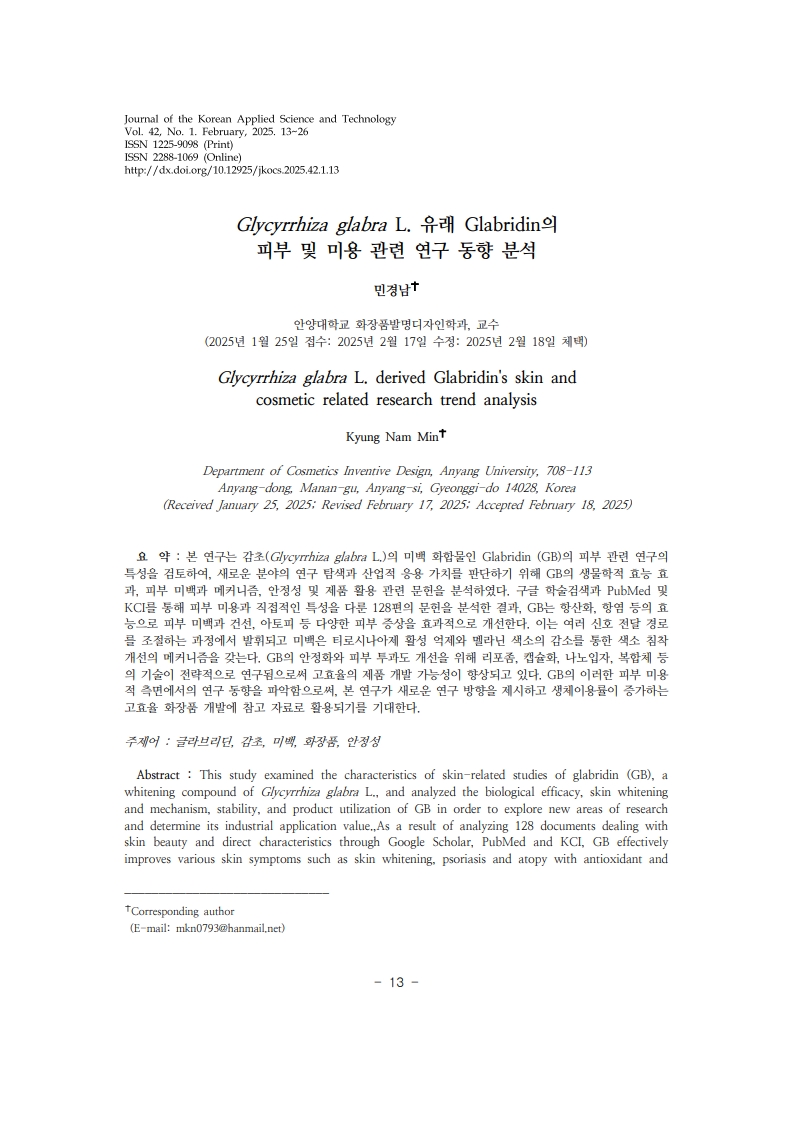
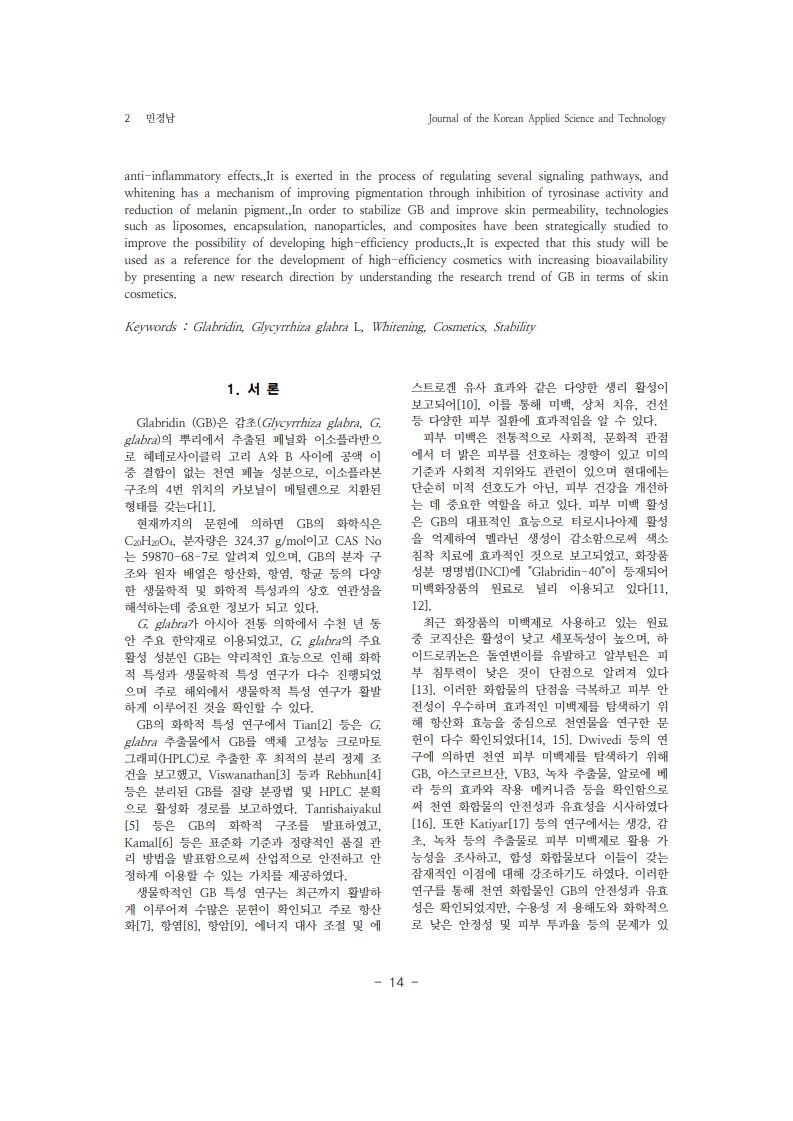
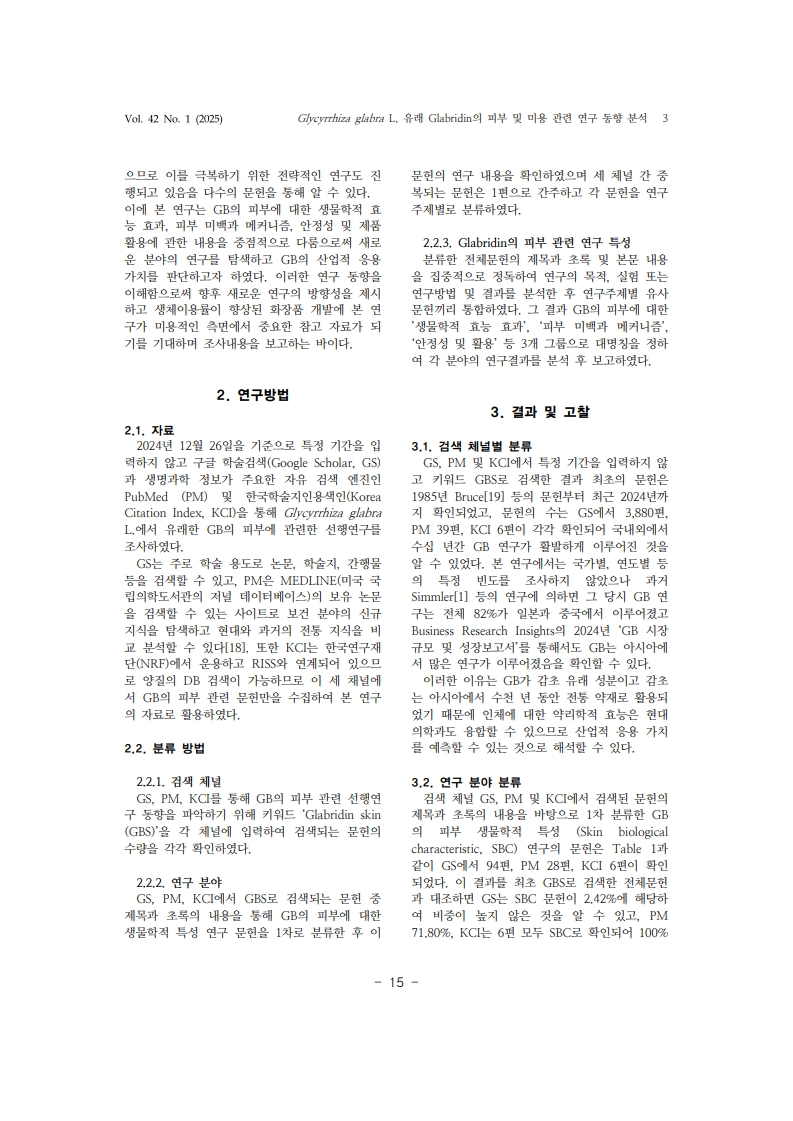
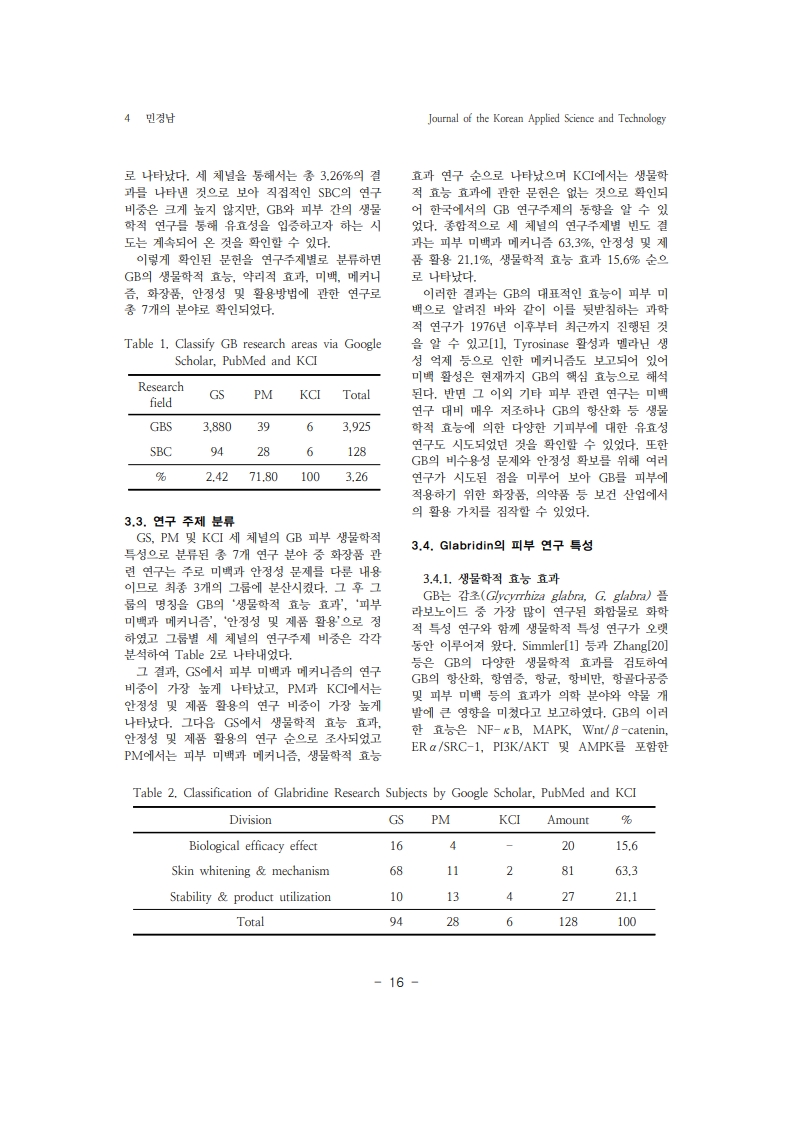
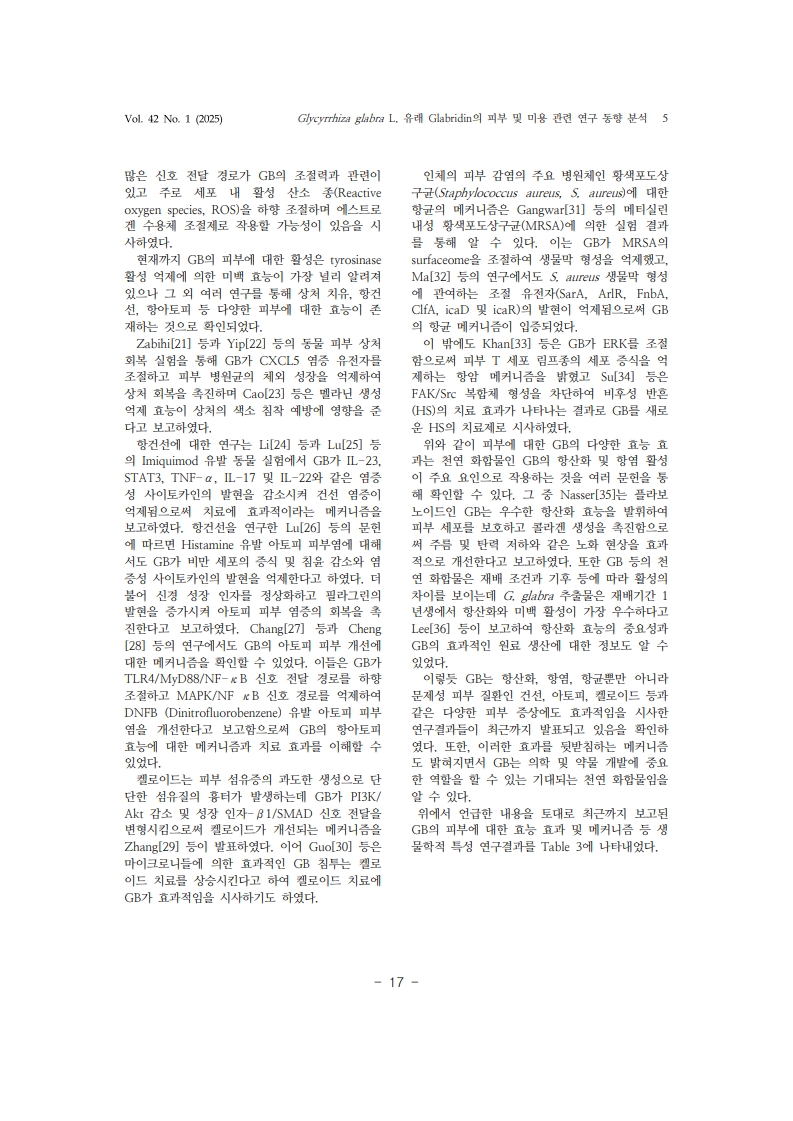

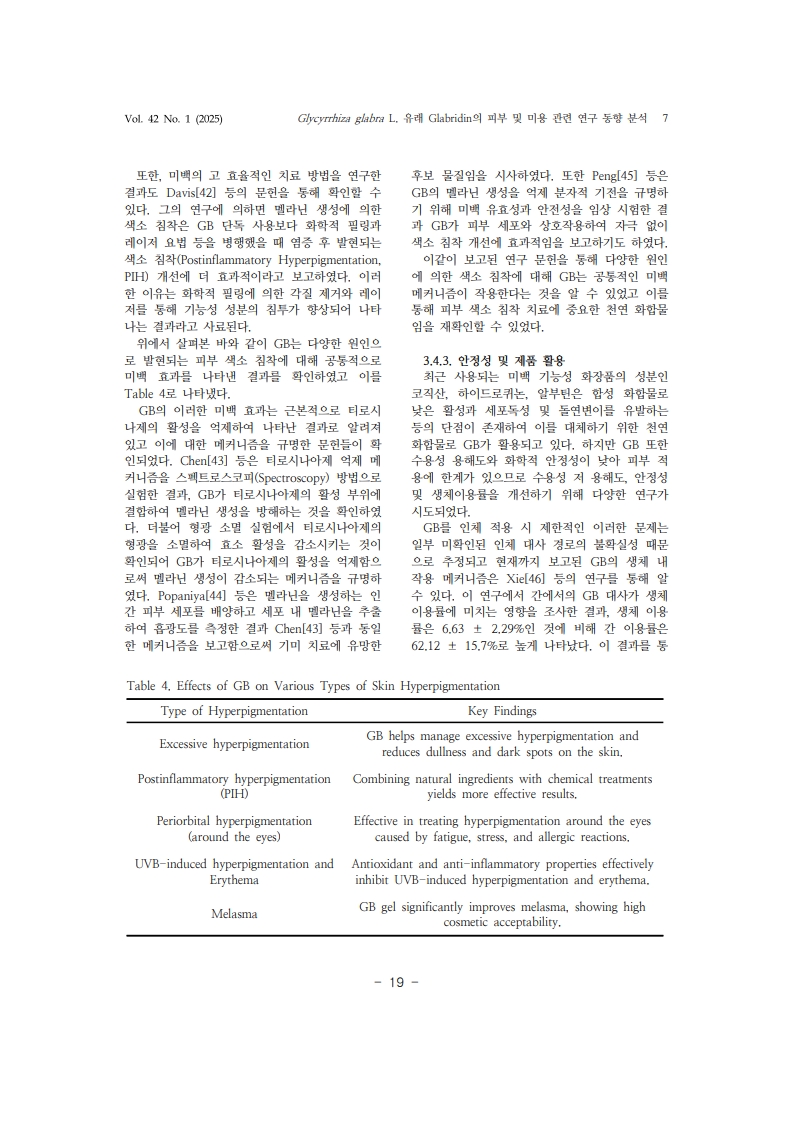
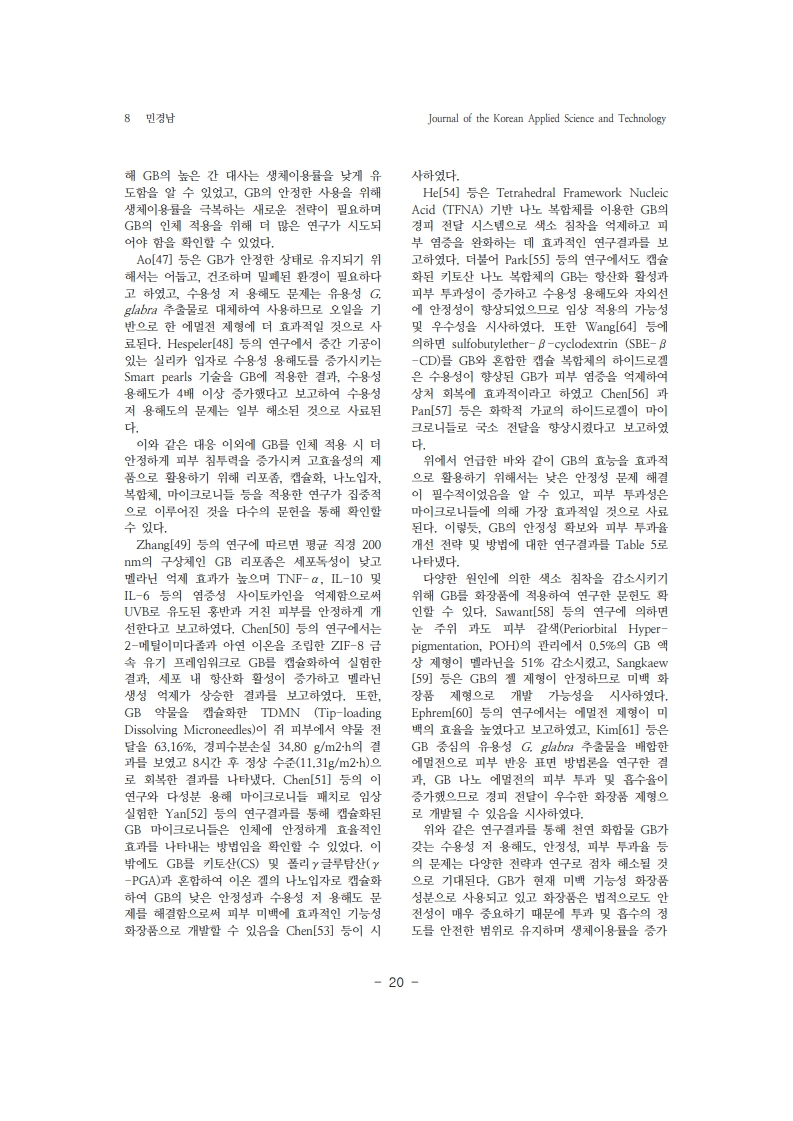
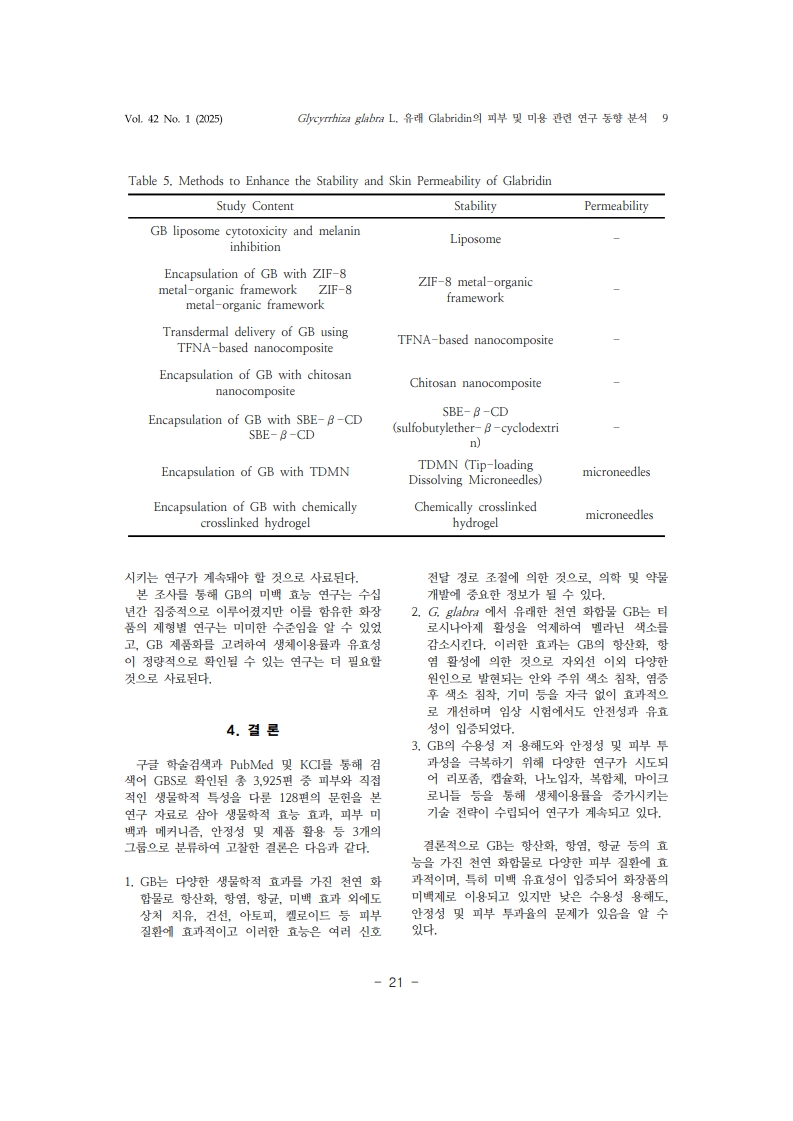
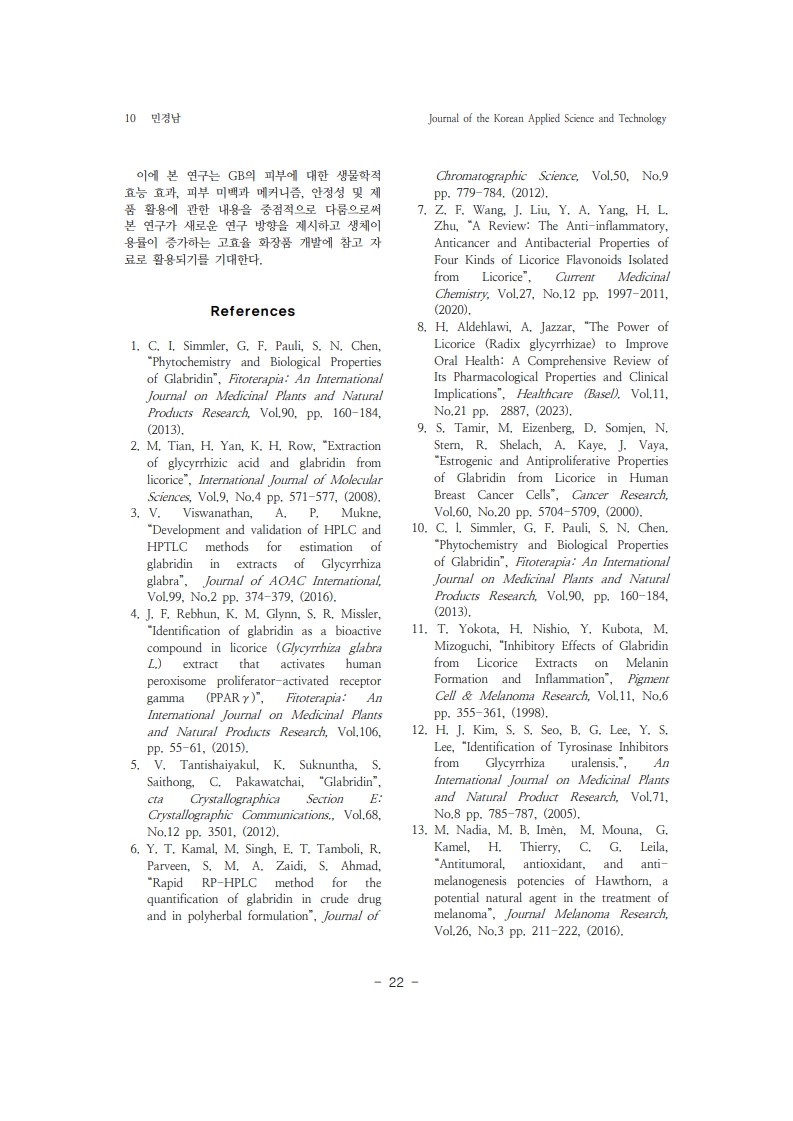
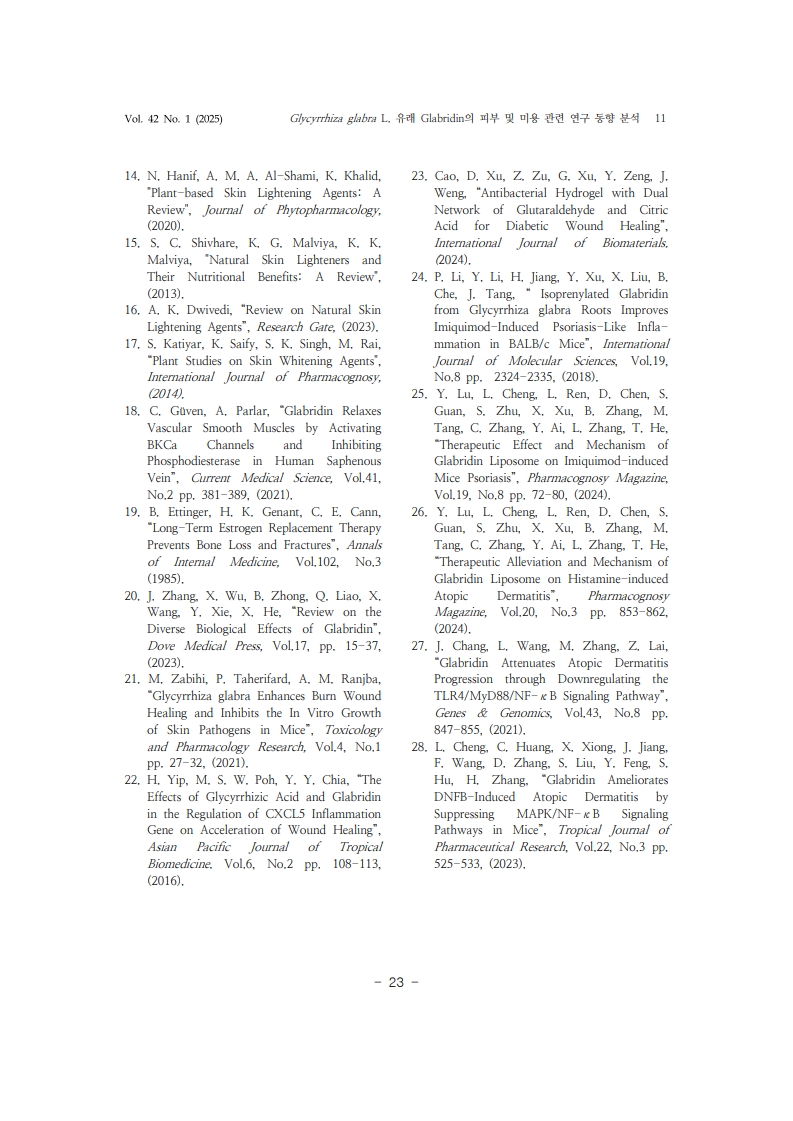

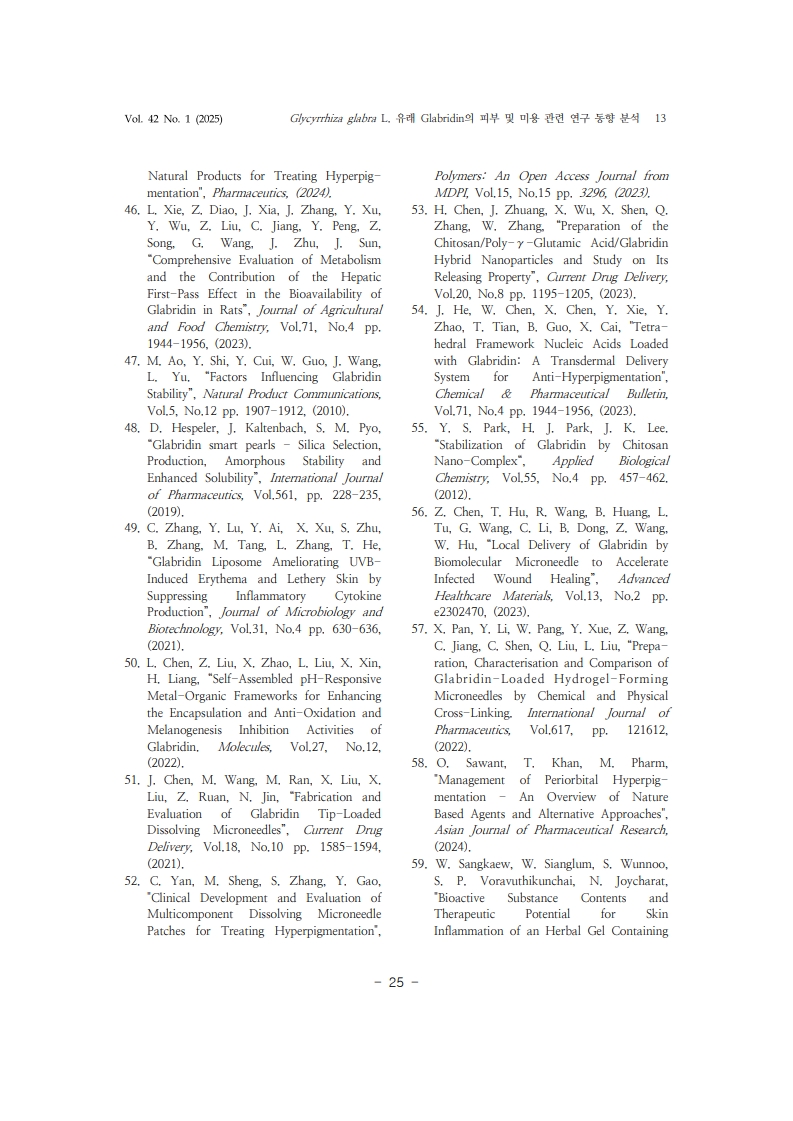
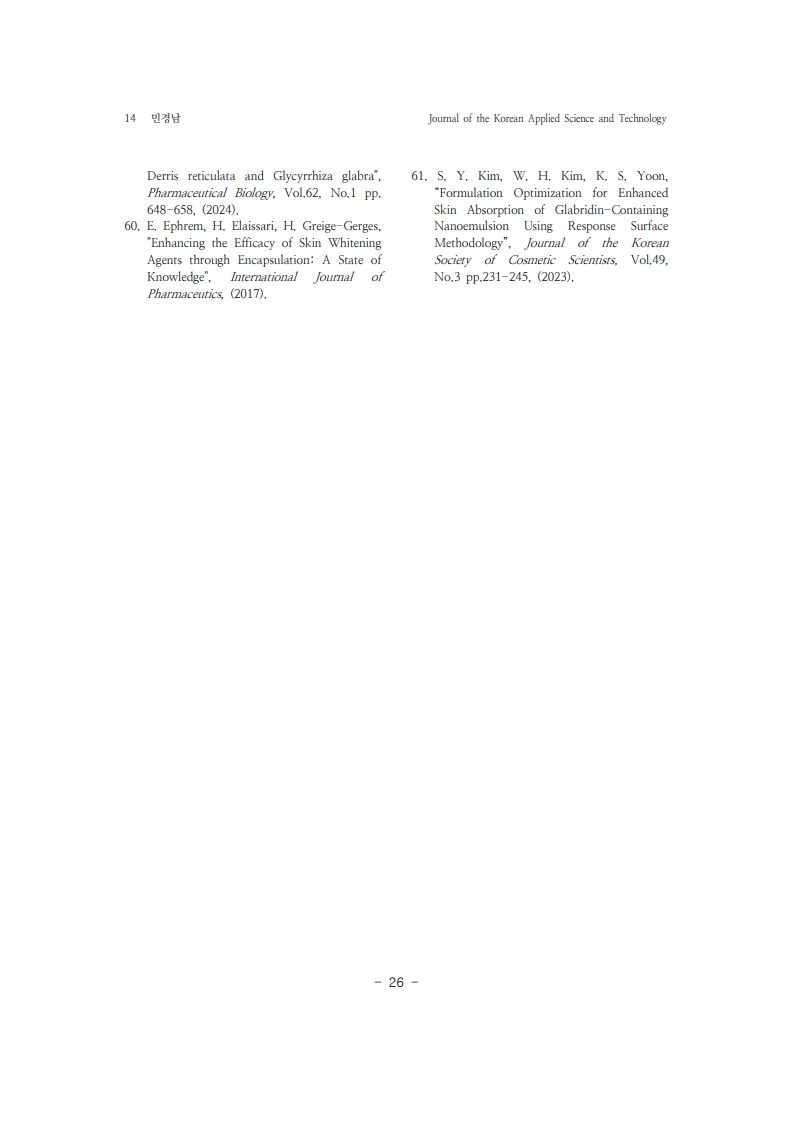
1. C. I. Simmler, G. F. Pauli, S. N. Chen, “Phytochemistry and Biological Propertiesof Glabridin”, Fitoterapia: An International Journal on Medicinal Plants and Natural
Products Research, Vol.90, pp. 160-184, (2013).
2. M. Tian, H. Yan, K. H. Row, “Extraction of glycyrrhizic acid and glabridin fromlicorice”, International Journal of MolecularSciences, Vol.9, No.4 pp. 571-577, (2008).
3. V. Viswanathan, A. P. Mukne, “Development and validation of HPLC andHPTLC methods for estimation of glabridin in extracts of Glycyrrhiza
glabra”, Journal of AOAC International, Vol.99, No.2 pp. 374-379, (2016).
4. J. F. Rebhun, K. M. Glynn, S. R. Missler, “Identification of glabridin as a bioactive compound in licorice (Glycyrrhiza glabra L.) extract that activates human
peroxisome proliferator-activated receptor gamma (PPARγ)”, Fitoterapia: An International Journal on Medicinal Plants and Natural Products Research, Vol.106,
pp. 55-61, (2015).
5. V. Tantishaiyakul, K. Suknuntha, S. Saithong, C. Pakawatchai, “Glabridin”,cta Crystallographica Section E: Crystallographic Communications., Vol.68,
No.12 pp. 3501, (2012).
6. Y. T. Kamal, M. Singh, E. T. Tamboli, R. Parveen, S. M. A. Zaidi, S. Ahmad,“Rapid RP-HPLC method for the quantification of glabridin in crude drug
and in polyherbal formulation”, Journal of Chromatographic Science, Vol.50, No.9pp. 779-784. (2012).
7. Z. F. Wang, J. Liu, Y. A. Yang, H. L. Zhu, “A Review: The Anti-inflammatory,Anticancer and Antibacterial Properties of Four Kinds of Licorice Flavonoids Isolated from Licorice”, Current Medicinal Chemistry, Vol.27, No.12 pp. 1997-2011, (2020).
8. H. Aldehlawi, A. Jazzar, “The Power of Licorice (Radix glycyrrhizae) to ImproveOral Health: A Comprehensive Review of Its Pharmacological Properties and Clinical
Implications”, Healthcare (Basel). Vol.11, No.21 pp. 2887, (2023).
9. S. Tamir, M. Eizenberg, D. Somjen, N. Stern, R. Shelach, A. Kaye, J. Vaya, “Estrogenic and Antiproliferative Properties of Glabridin from Licorice in Human Breast Cancer Cells”, Cancer Research, Vol.60, No.20 pp. 5704-5709, (2000).
10. C. l. Simmler, G. F. Pauli, S. N. Chen. “Phytochemistry and Biological Properties of Glabridin”, Fitoterapia: An International Journal on Medicinal Plants and Natural Products Research, Vol.90, pp. 160-184, (2013).
11. T. Yokota, H. Nishio, Y. Kubota, M. Mizoguchi, “Inhibitory Effects of Glabridinfrom Licorice Extracts on Melanin Formation and Inflammation”, Pigment
Cell & Melanoma Research, Vol.11, No.6 pp. 355-361, (1998).
12. H. J. Kim, S. S. Seo, B. G. Lee, Y. S. Lee, “Identification of Tyrosinase Inhibitors from Glycyrrhiza uralensis.”, An International Journal on Medicinal Plants
and Natural Product Research, Vol.71, No.8 pp. 785-787, (2005).
13. M. Nadia, M. B. Imèn, M. Mouna, G. Kamel, H. Thierry, C. G. Leila,“Antitumoral, antioxidant, and antimelanogenesispotencies of Hawthorn, a potential natural agent in the treatment of melanoma”, Journal Melanoma Research,Vol.26, No.3 pp. 211-222, (2016).
14. N. Hanif, A. M. A. Al-Shami, K. Khalid, "Plant-based Skin Lightening Agents: AReview", Journal of Phytopharmacology,(2020).
15. S. C. Shivhare, K. G. Malviya, K. K. Malviya, "Natural Skin Lighteners andTheir Nutritional Benefits: A Review", (2013).
16. A. K. Dwivedi, “Review on Natural Skin Lightening Agents”, Research Gate, (2023).
17. S. Katiyar, K. Saify, S. K. Singh, M. Rai, “Plant Studies on Skin Whitening Agents", International Journal of Pharmacognosy, (2014).
18. C. Güven, A. Parlar, “Glabridin Relaxes Vascular Smooth Muscles by ActivatingBKCa Channels and Inhibiting Phosphodiesterase in Human Saphenous
Vein”, Current Medical Science, Vol.41, No.2 pp. 381-389, (2021).
19. B. Ettinger, H. K. Genant, C. E. Cann, “Long-Term Estrogen Replacement TherapyPrevents Bone Loss and Fractures”, Annals of Internal Medicine, Vol.102, No.3 (1985).
20. J. Zhang, X. Wu, B. Zhong, Q. Liao, X. Wang, Y. Xie, X. He, “Review on theDiverse Biological Effects of Glabridin”, Dove Medical Press, Vol.17, pp. 15-37,
(2023).
21. M. Zabihi, P. Taherifard, A. M. Ranjba, “Glycyrrhiza glabra Enhances Burn Wound Healing and Inhibits the In Vitro Growth of Skin Pathogens in Mice”, Toxicology and Pharmacology Research, Vol.4, No.1 pp. 27-32, (2021).
22. H. Yip, M. S. W. Poh, Y. Y. Chia, “The Effects of Glycyrrhizic Acid and Glabridin in the Regulation of CXCL5 Inflammation Gene on Acceleration of Wound Healing”,Asian Pacific Journal of Tropical Biomedicine. Vol.6, No.2 pp. 108-113, (2016).
23. Cao, D. Xu, Z. Zu, G. Xu, Y. Zeng, J. Weng, “Antibacterial Hydrogel with Dual Network of Glutaraldehyde and Citric Acid for Diabetic Wound Healing”,
International Journal of Biomaterials. (2024).
24. P. Li, Y. Li, H. Jiang, Y. Xu, X. Liu, B. Che, J. Tang, “ Isoprenylated Glabridinfrom Glycyrrhiza glabra Roots Improves Imiquimod-Induced Psoriasis-Like Inflammationin BALB/c Mice”, International Journal of Molecular Sciences, Vol.19,No.8 pp. 2324-2335, (2018).
25. Y. Lu, L. Cheng, L. Ren, D. Chen, S. Guan, S. Zhu, X. Xu, B. Zhang, M.Tang, C. Zhang, Y. Ai, L. Zhang, T. He, “Therapeutic Effect and Mechanism of
Glabridin Liposome on Imiquimod-induced Mice Psoriasis”, Pharmacognosy Magazine, Vol.19, No.8 pp. 72-80, (2024).
26. Y. Lu, L. Cheng, L. Ren, D. Chen, S. Guan, S. Zhu, X. Xu, B. Zhang, M.Tang, C. Zhang, Y. Ai, L. Zhang, T. He, “Therapeutic Alleviation and Mechanism of
Glabridin Liposome on Histamine-inducedAtopic Dermatitis”, Pharmacognosy Magazine, Vol.20, No.3 pp. 853-862,(2024).
27. J. Chang, L. Wang, M. Zhang, Z. Lai, “Glabridin Attenuates Atopic DermatitisProgression through Downregulating the TLR4/MyD88/NF-κB Signaling Pathway”,
Genes & Genomics, Vol.43, No.8 pp. 847-855, (2021).
28. L. Cheng, C. Huang, X. Xiong, J. Jiang, F. Wang, D. Zhang, S. Liu, Y. Feng, S.Hu, H. Zhang, “Glabridin Ameliorates DNFB-Induced Atopic Dermatitis by
Suppressing MAPK/NF-κB Signaling Pathways in Mice”, Tropical Journal ofPharmaceutical Research, Vol.22, No.3 pp. 525-533, (2023).
29. Q. Zhang, D. Qian, D. D. Tang, J. Liu, L. Y. Wang, W. Chen, C. J. Wu, W.Peng, “Glabridin from Glycyrrhiza glabra Possesses a Therapeutic Role against
Keloid via Attenuating PI3K/Akt and Transforming Growth Factor-β1/SMADSignaling Pathways”, Journal of Agricultural and Food Chemistry, Vol.70,
No.35 pp. 10782-10793, (2022).
30. J. Guo, Z. Chen, R. Huang, D. Tang, Y. Wang, P. Song, L. Mei, S. Hou, W. Peng, L. He, Dec, “Development and optimizationof the Glabridin-loaded dissolving microneedle for enhanced treatment of keloid”, International Journal of Pharmaceutics, Vol.8, pp. 100267, (2024).
31. B. Gangwar, S. Kumar, M. P. Darokar, “Inhibition of Methicillin-ResistantStaphylococcus aureus Biofilm Formation by Modulating the Surfaceome with
Glabridin”, Vol.70, (2020).
32. Y. Ma, Y. Mao, X. Kang, B. Zhang, J. Wang, G. Wang, G. Wang, “TranscriptomicAnalysis of the Effect of Glabridin on Biofilm Formation in Staphylococcus auréus”, Foodborne Pathogens and Disease, (2024).
33. A. Q. Khan, M.V. Agha, F. Ahmad, R. Anver,“The Critical Role of ERK inRegulating Metabolic Pathways Related to the Proliferation of Human Skin T-Cell
Lymphoma Cells Treated with Glabridin”, Cell Biology International, (2024).
34. L. Su, X. Li, X. Wu, B. Hui, S. Han, J. Gao, Y. Li, J. Shi, H. Zhu, B. Zhao, D.Hu, “Simultaneous Deactivation of FAK and Src Improves the Pathology of
Hypertrophic Scar”, Scientific Reports, Vol.6, No.1 pp. 26023, (2024).
35. W. Nasser, “New Developments in AntiAgingPlants: A Review”, Pharmacology Online, (2021).
36. H. W. Lee, B. N. Song, S. G. Park, “Antioxidant and Whitening Activities ofLicorice Extracts with Different Cultivation Periods”, Journal of East Asian Dietary
Life, Vol.32, No.4 pp. 225-231, (2022)
37. J. J. Leyden, B. Shergill, G. Micali, "Natural Options for Managing Hyperpigmentation",Journal of the American Academy of Dermatology, (2011).
38. M. Kanlayavattanakul, N. Lourith, "Herbal Treatments for Skin Hyperpigmentation: A Review of Clinical Evidence", Journal of Cosmetic and Laser Therapy, (2018).
39. R. Mansuri, A. Diwan, H. Kumar, K. Dangwal, “Potential of Natural Compounds as Sunscreen Agents", Pharmacognosy Reviews, (2021).
40. O. Sawant, T. Khan, "Natural-based therapies and alternative approaches for periorbital hyperpigmentation: A review", Dermatologic Therapy, Vol.33, No.4 pp.
13717, (2020).
41. H. Seino, Y. Arai, N. Nagao, N. Ozawa, K. Hamada, "Efficient transdermal delivery of glabridin using cationic ionomer complex micelles", PLOS ONE, (2016).
42. E. C. Davis, V. D. Callender, "Postinflammatoryhyperpigmentation: a review ofepidemiology, clinical features, and treatment options in skin of color", Journal
of Clinical and Aesthetic Dermatology, Vol.20107, No.3 pp. 20-31, (2010).
43. J. Chen, X. Yu, Y. Huang, "Inhibitory Mechanism of Glabridin on Tyrosinase",Spectrochimica Acta A: Molecular and Biomolecular Spectroscopy, Vol.168, pp.111-117, (2016).
44. H. S. Popaniya, P. N. Vaja, C. J. Tank, "Tyrosinase Inhibition: A PotentMechanism of Action of Plants Used in Treatment of Melasma", Asian Journal of
Pharmaceutical Research, pp. 289-294, (2024).
45. X. Peng, Y. Ma, C. Yan, X. Wei, L. Zhang, H. Jiang, Y. Ma, "Mechanisms,Formulations, and Efficacy Evaluation of Natural Products for Treating Hyperpigmentation",Pharmaceutics, (2024).
46. L. Xie, Z. Diao, J. Xia, J. Zhang, Y. Xu, Y. Wu, Z. Liu, C. Jiang, Y. Peng, Z.Song, G. Wang, J. Zhu, J. Sun, “Comprehensive Evaluation of Metabolism
and the Contribution of the Hepatic First-Pass Effect in the Bioavailability ofGlabridin in Rats”, Journal of Agricultural and Food Chemistry, Vol.71, No.4 pp.
1944-1956, (2023).
47. M. Ao, Y. Shi, Y. Cui, W. Guo, J. Wang, L. Yu. “Factors Influencing GlabridinStability”, Natural Product Communications,Vol.5, No.12 pp. 1907-1912, (2010).
48. D. Hespeler, J. Kaltenbach, S. M. Pyo, “Glabridin smart pearls - Silica Selection, Production, Amorphous Stability and Enhanced Solubility”, International Journal of Pharmaceutics, Vol.561, pp. 228-235, (2019).
49. C. Zhang, Y. Lu, Y. Ai, X. Xu, S. Zhu, B. Zhang, M. Tang, L. Zhang, T. He,“Glabridin Liposome Ameliorating UVBInducedErythema and Lethery Skin by
Suppressing Inflammatory Cytokine Production”, Journal of Microbiology andBiotechnology, Vol.31, No.4 pp. 630-636, (2021).
50. L. Chen, Z. Liu, X. Zhao, L. Liu, X. Xin, H. Liang, “Self-Assembled pH-Responsive Metal-Organic Frameworks for Enhancing the Encapsulation and Anti-Oxidation and Melanogenesis Inhibition Activities of Glabridin. Molecules, Vol.27, No.12, (2022).
51. J. Chen, M. Wang, M. Ran, X. Liu, X. Liu, Z. Ruan, N. Jin, “Fabrication andEvaluation of Glabridin Tip-Loaded Dissolving Microneedles”, Current Drug
Delivery, Vol.18, No.10 pp. 1585-1594, (2021).
52. C. Yan, M. Sheng, S. Zhang, Y. Gao, "Clinical Development and Evaluation ofMulticomponent Dissolving Microneedle Patches for Treating Hyperpigmentation",
Polymers: An Open Access Journal from MDPI, Vol.15, No.15 pp. 3296, (2023).
53. H. Chen, J. Zhuang, X. Wu, X. Shen, Q. Zhang, W. Zhang, “Preparation of theChitosan/Poly-γ-Glutamic Acid/Glabridin Hybrid Nanoparticles and Study on Its
Releasing Property”, Current Drug Delivery,Vol.20, No.8 pp. 1195-1205, (2023).
54. J. He, W. Chen, X. Chen, Y. Xie, Y. Zhao, T. Tian, B. Guo, X. Cai, "TetrahedralFramework Nucleic Acids Loaded with Glabridin: A Transdermal Delivery
System for Anti-Hyperpigmentation", Chemical & Pharmaceutical Bulletin,Vol.71, No.4 pp. 1944-1956, (2023).
55. Y. S. Park, H. J. Park, J. K. Lee. “Stabilization of Glabridin by ChitosanNano-Complex“, Applied Biological Chemistry, Vol.55, No.4 pp. 457-462. (2012).
56. Z. Chen, T. Hu, R. Wang, B. Huang, L. Tu, G. Wang, C. Li, B. Dong, Z. Wang,W. Hu, “Local Delivery of Glabridin by Biomolecular Microneedle to Accelerate
Infected Wound Healing”, Advanced Healthcare Materials, Vol.13, No.2 pp. e2302470, (2023).
57. X. Pan, Y. Li, W. Pang, Y. Xue, Z. Wang,C. Jiang, C. Shen, Q. Liu, L. Liu, “Preparation,Characterisation and Comparison of Glabridin-Loaded Hydrogel-Forming Microneedles by Chemical and PhysicalCross-Linking. International Journal of Pharmaceutics, Vol.617, pp. 121612, (2022).
58. O. Sawant, T. Khan, M. Pharm, "Management of Periorbital Hyperpigmentation- An Overview of Nature Based Agents and Alternative Approaches",
Asian Journal of Pharmaceutical Research, (2024).
59. W. Sangkaew, W. Sianglum, S. Wunnoo, S. P. Voravuthikunchai, N. Joycharat,"Bioactive Substance Contents and Therapeutic Potential for Skin
Inflammation of an Herbal Gel Containing Derris reticulata and Glycyrrhiza glabra",Pharmaceutical Biology, Vol.62, No.1 pp. 648-658, (2024).
60. E. Ephrem, H. Elaissari, H. Greige-Gerges, "Enhancing the Efficacy of Skin Whitening Agents through Encapsulation: A State of Knowledge", International Journal of Pharmaceutics, (2017).
61. S. Y. Kim, W. H. Kim, K. S. Yoon, “Formulation Optimization for EnhancedSkin Absorption of Glabridin-Containing Nanoemulsion Using Response Surface
Methodology”, Journal of the Korean Society of Cosmetic Scientists, Vol.49,No.3 pp.231-245, (2023).

